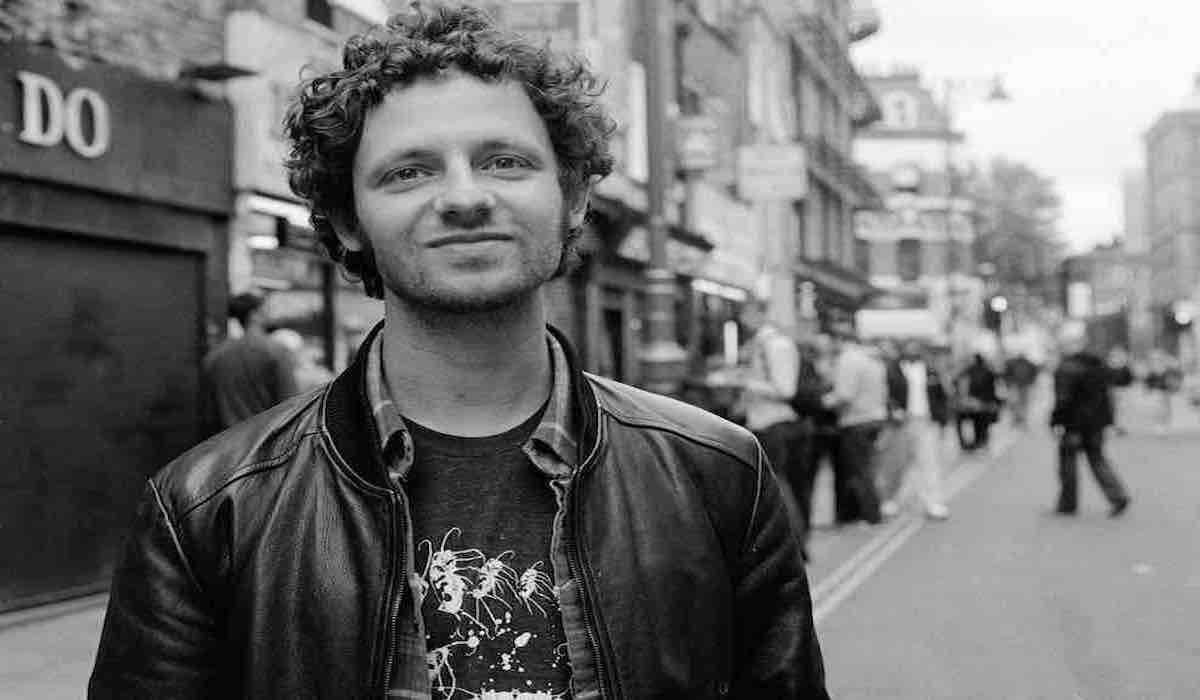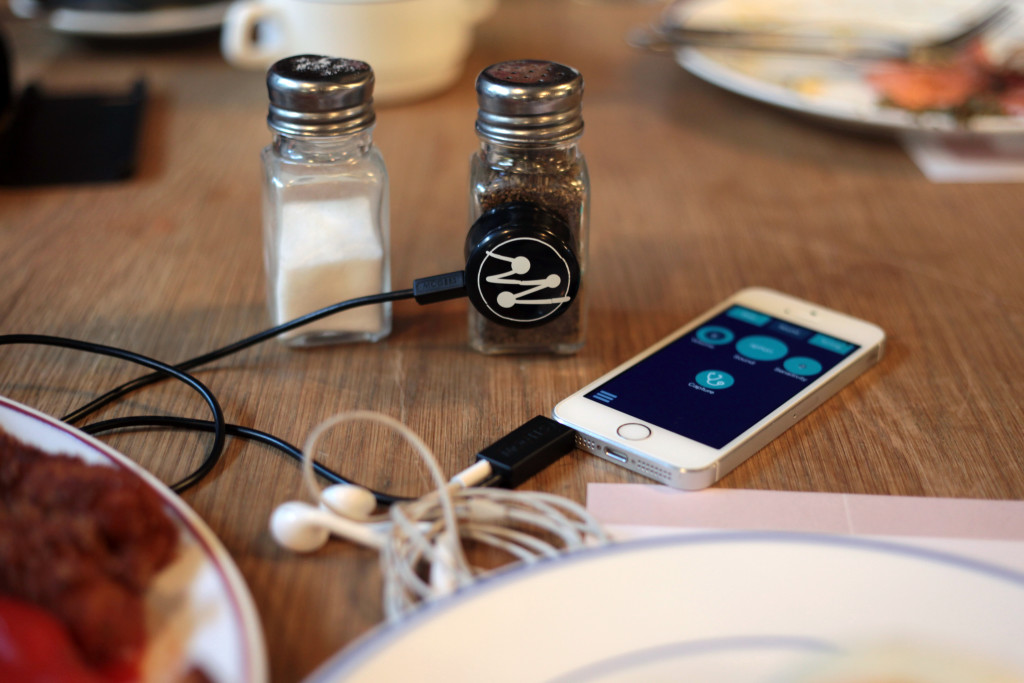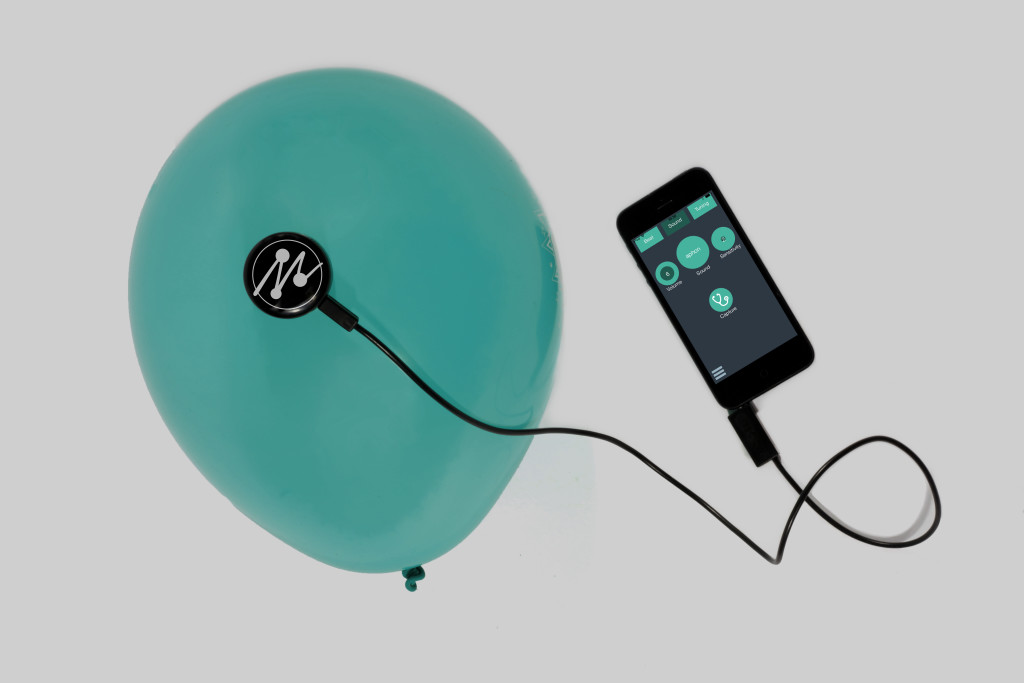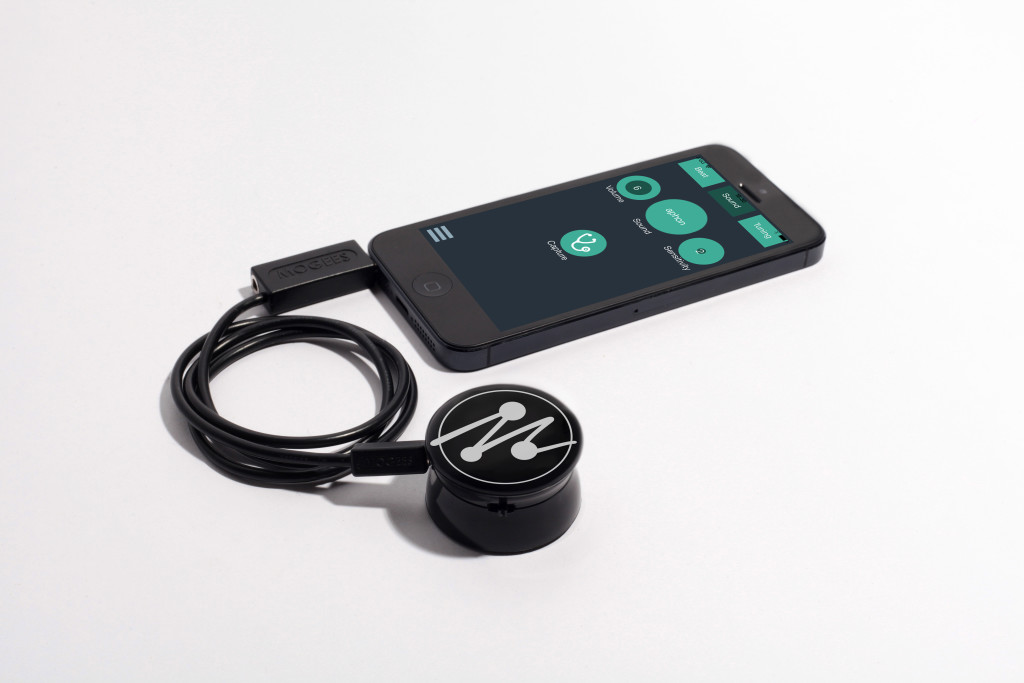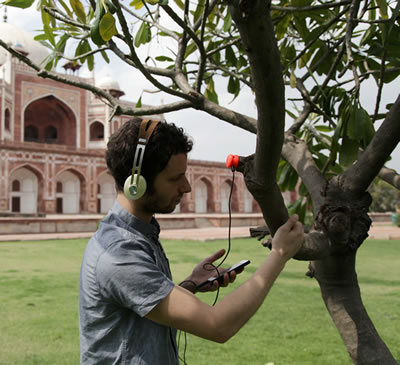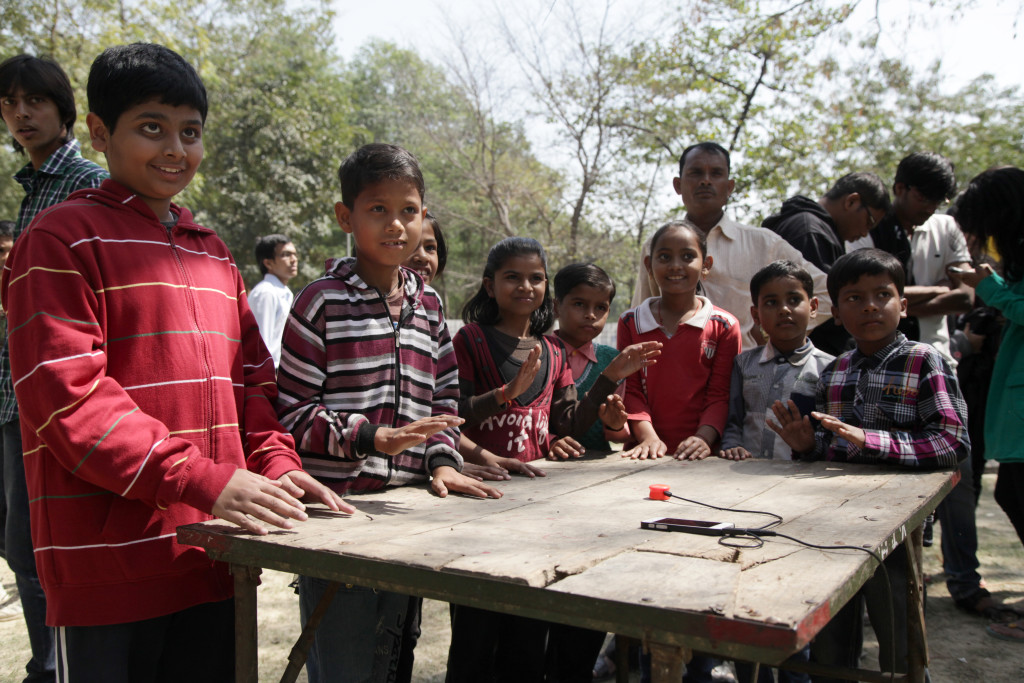Bruno Zamborlin è un ragazzo semplice, accento veneto intercalato con espressioni squisitamente inglesi. Quando parla della propria creatura, Mogees, lo fa come un papà fiero del bambino, è quasi impossibile fermarlo. E’ un ragazzo che ha girato il mondo, che ha studiato, che ha saputo sfruttare due passioni, quella per la musica e quella per la tecnologia, per inventare uno strumento rivoluzionario, in grado di far suonare il mondo che ci circonda. Tra un impegno e l’altro, nell’ufficio di Londra, ci ha raccontato dei suoi studi, di Mogees, della neonata compagnia e dei prossimi eventi che lo vedranno protagonista.
Prima di iniziare a parlare di Mogees, lo strumento da te creato, vorremmo conoscerti un po’ meglio. Sei italiano, hai 30 anni e da quattro vivi a Londra. Che studi hai compiuto, come sei approdato oltre Manica?
Ho studiato informatica facendo la triennale a Padova e la specialistica a Bologna, con in mezzo un Erasmus in Olanda. A marzo del 2008 mi sono trasferito a Parigi, inizialmente per uno stage, e poi mi hanno assunto in un centro di ricerca musicale che si chiama IRCAM, che si trova in una parte del Centre Pompidou; è il centro più grande in Europa per ricerca di musica e nuova tecnologia. L’idea portante è che i ricercatori lavorino a stretto contatto con musicisti e compositori, in modo che uno serva da stimolo all’altro. Dopo tre anni, a gennaio 2011, ho vinto una borsa di studio per un dottorato a tempo pieno a Londra, nell’università Goldsmith, sempre sotto la tutela dell’IRCAM.
Mogees è l’applicazione che consente di trasformare qualsiasi oggetto comune in uno strumento musicale, attraverso un sensore collegato ad uno smartphone. Com’è nata l’idea?
Fin dai tempi di Bologna ho sempre usato le nuove tecnologie per inventare strumenti musicali. Durante il secondo anno di dottorato ho creato l’ultimo di questi, Mogees, con l’idea che tutto quello che ci circonda può diventare uno strumento musicale! Dal punto di vista tecnologico ho sempre lavorato a sistemi in grado di riconoscere i movimenti ed i gesti del corpo umano, e ho cercato di usare questa intelligenza per controllare la musica elettronica. Ad un certo punto, stanco di usare sensori costosi, telecamere, computer, schede audio che si trovano solo all’interno di certi studi, ho cercato di fare qualcosa di simile, tentando di portare la musica elettronica in tempo reale per strada, e suonarla come se fosse un vero strumento. E questo nel modo più comodo possibile.
Dal momento che non tutti s’intendono di tecnologia, riesci a spiegare a noi comuni mortali come funziona l’app?
Mogees è la combinazione di un sensore che si collega con un cavo ad un iPhone (per ora) e si attacca a qualunque oggetto rigido in grado di emettere delle vibrazioni. Il sensore trasforma tutte queste vibrazioni in un segnale audio che attraverso un software, che ho scritto durante il dottorato, e che stiamo migliorando giorno dopo giorno, le trasforma istantaneamente in musica. Il cavo può essere connesso a delle cuffie o ad un sound system per ascoltare la musica prodotta in tempo reale quando tocchiamo l’oggetto.
Nel video esplicativo racconti in maniera chiara che Mogees può essere utilizzato dal musicista professionista ma anche dal ballerino, dal bambino, dalla persona comune. Inizialmente avevi concepito un’app che potesse essere usata esclusivamente in maniera professionale o fin da subito hai immaginato che sarebbe stata un ottimo strumento per il puro e semplice divertimento?
Secondo me Mogees è una grande rivoluzione nel mondo delle tecnologie di questi ultimi anni, quella della realtà aumentata, contrapposta alla realtà virtuale (quella dei videogiochi per esempio). Alla base c’è l’idea che tu in prima persona devi capire un insieme di regole dettate dal designer e dal programmatore, leggerti il manuale d’istruzioni, per comprendere come funziona. La realtà aumentata consente di utilizzare quello che il mondo attorno a noi ci offre, sfruttando la nostra conoscenza a priori per farla diventare uno strumento musicale. Questo approccio è molto semplice da utilizzare perché non viene imposta nessuna regola su come interagire con Mogees, che è al contrario quello che ti insegnano a fare con gli strumenti acustici, per esempio il pianoforte: si impara la postura corretta, come muovere le mani ecc. Se l’utente vuole suonare con le mani, con i piedi, con un archetto può comunque farlo. Ho osservato che anche i non musicisti possono usarlo con facilità. Le persone vengono incoraggiate a sfruttare le capacità artistiche che già possiedono: la ballerina utilizzerà i piedi, il bambino le posate e così via.
Da come muovi le mani deduciamo che tu sia un percussionista, o forse lo sei diventato a forza di suonare oggetti! Hai un background musicale che ti ha aiutato nello sviluppo di Mogees?
Non ho mai preso lezioni però suono le percussioni, ho fatto un po’ di tabla (male!), ma credo che tutto sia derivato da ore e ore a suonare Mogees, quindi ho imparato completamente da autodidatta! Però ho sempre suonato musica, in Italia, e ho partecipato a vari progetti quando ero Parigi, continuando anche adesso.
Il 19 marzo si è conclusa positivamente la campagna su Kickstarter volta a raccogliere fondi per lo sviluppo e la produzione di Mogees. Com’è stato l’intero percorso? Ed il prossimo passo?
Ho pubblicato un video su YouTube che presentava Mogees e quando sono tornato dalle vacanze era completamente esploso! Ci sono state quasi 300 mila visualizzazioni, moltissime e-mail che mi chiedevano come comprare lo strumento o ancora come potermi aiutare a commercializzarlo, e quello è stato il calcio d’inizio. Da quel momento ho aperto una limited company che ho chiamato Mogees Limited con la collaborazione di Anthony Walton, il mio CEO, che si è occupato degli aspetti contrattuali. Ho avuto fondi iniziali da amici e parenti, che sono durati per i primi 3, 4 mesi, poi David Zicarelli, fondatore di Cycling ’74, ha deciso di finanziare una parte della compagnia, diventando uno dei direttori insieme a me ed Anthony. A marzo abbiamo deciso di iniziare un Kickstarter per avere fondi e visibilità ed è andato molto meglio delle più rosee aspettative! Abbiamo pre venduto 1600 unità e da quel momento è stato estremamente facile trovare altri investimenti. Recentemente siamo stati anche finanziati da un ente italiano, M31, capitanato da Ruggero Frezza e con loro siamo a posto per un bel po’ di mesi. Attualmente sto assumendo il personale per la compagnia e stiamo procedendo a tutta birra!
Hai collaborato con numerosi musicisti, come i Plaid, Rodrigo y Gabriela, Vicente Amigo. Come è stata accolta Mogees da chi ha fatto della musica la propria carriera? E quali sono i tuoi progetti per il futuro? Ti troveremo in giro a suonare?
Ho notato che tutti quanti sono riusciti a fare quello che secondo me è il più grande successo per lo strumento: l’hanno incorporato nel loro background. Per esempio i Plaid hanno usato Mogees per creare i suoni dei loro concerti, però suona Plaid; Rodrigo lo suona esattamente come suonerebbe la propria chitarra acustica. Quindi Mogees è riuscito ad essere abbastanza flessibile da poter essere incorporato in una pratica musicale già esistente. E questo è un grande successo che con la musica elettronica non avviene praticamente mai! Abbiamo appena fatto un’installazione a Parigi davanti al Pompidou e a Covent Garden a Londra, siamo poi stati al Sonar a Barcellona. Dal punto di vista artistico attualmente sto suonando con i Plaid, suoneremo al Riverb Festival a Londra, invitati da Imogen Heap, e a settembre saremo al MTV Digital Days a Torino. Insomma stiamo partecipando ad un bel po’ di eventi!
Creatività è la parola d’ordine per noi di The WalkMan, e mi sembra che tu ne abbia tanta! C’è un consiglio che potresti dare ad un giovane che come te vuole trasformare la propria passione in lavoro?
Domanda difficile perché ogni caso è a se stante. Io credo che quando fai una cosa, e ti diverti nel farla, non ti pesa passarci sopra le nottate e i weekend, come è successo a me. Divertirsi è il requisito fondamentale per eccellere! Perché se quando lavori non vedi l’ora di andartene, chiaramente non farai mai nulla in più rispetto agli altri, sarai sempre una goccia nel mare. Un’altra cosa molto importante di ciò che ho fatto io è interpretare lo scrivere il software come una forma d’arte, un medium per esprimermi artisticamente, come un pittore usa la sua tela e un violinista il violino. Siamo in una fase in cui scrivere codici sta diventando sempre più semplice e può essere uno strumento per altre persone per creare qualcosa a loro volta. E’ un’opera che genera altre opere.
Photo Credits: Camila Jurado
[divider]ENGLISH VERSION[/divider]
Bruno Zamborlin is a simple guy, with a Venetian accent interspersed with exquisitely English expressions. When he talks about his own creature, Mogees, he seems a father proud of his child. It is almost impossible to stop him. He traveled the world, studying and capitalized on his passion for music and technology to invent a revolutionary tool, able to play the world around us. Between his commitments, in his Londoner studio, he told us of his studies, of Mogees, the recently founded company and of the upcoming events that will see him as the protagonist.
Before start talking about Mogees, the tool you created, I would like to know a little better. You are Italian, 30 and you are living in London for four years. What studies have you done? How did you get across the Channel?
I studied computer science, doing the bachelor degree in Padua and the master degree in Bologna, in the midst I went in Erasmus in the Netherlands. In March 2008 I moved to Paris, initially for an internship, and then I had been hired into a musical research center called IRCAM, which is located in a part of the Pompidou Centre. It is the largest center in Europe for music research and new technology. The main idea is that researchers work closely with musicians and composers, so that one will serve as a stimulus to another. Three years later, in January 2011, I won a scholarship to study for a doctorate full-time in London, Goldsmith University, under the tutelage of IRCAM.
Mogees is the application that allows you to turn any ordinary object into a musical instrument, through a sensor connected to the Smartphone. How did the idea arise?
Since I was in Bologna I always used new technology to invent musical instruments. During the second year of my PhD, I created the last of these, Mogees, with the idea that everything around us can become a musical instrument! From the technological point of view, I have always worked in systems that can recognize the movements and gestures of the human body, and I tried to use this intelligence to control electronic music. At one point, tired of using expensive sensors, cameras, computers, sound cards that are only found in some particular studies, I tried to do something similar, bringing electronic music in real time in road and playing as if it were a real instrument. And this in the most convenient possible way.
Since not everybody deals with technology, can you explain to us mere mortals how the app works?
Mogees is the combination of a sensor that is connected with a cable to an iPhone (for now) and it is attached to any rigid object that can emit vibrations. The sensor transforms these vibrations into an audio signal which, through a software I wrote during my PhD and that we are improving day by day, transforms them instantly into music. The cable can be connected to headphones or a sound system to listen to the music produced in real-time when we touch the object.
In the explanatory video, you say that Mogees can be used by professional musician but also by a dancer, a child or any common person. Did you initially designed an app that could be used only in a professional manner or immediately you imagined that it would be a great tool for the sheer fun?
I think Mogees is a great revolution in recent years’ world of technology, that of augmented reality, as opposed to virtual reality (that of video games, for example). At its core there is the idea that first you have to understand a set of rules dictated by the designer and the programmer; read your instruction manual to understand how it works. Augmented reality allows the use of what the world around us has, using our a priori knowledge to turn it into a musical instrument. This approach is very simple to use because there is no set rule on how to interact with Mogees, which is the contrary of what you are taught on acoustic instruments such as the piano: you learn the correct posture, how to move your hands, etc. If the user wants to play with his hands, his feet, with a bow, he can do it. I have observed that even non-musicians can use it with ease. People are encouraged to take advantage of the artistic skills they already possess: the dancer will use his feet, a child the cutlery and so on.
From the way you move your hands I infer that you are a percussionist, or maybe you have become a percussionist by persisting in play items! Do you have a musical background that helped you in Mogees’ development?
I never took lessons but I play percussions. I did a little tabla (bad!), but I think that everything derived from hours and hours playing Mogees, so I learned as completely self-taught! But I have always played music in Italy, and I participated in various projects when I was in Paris, continuing even now.
On March 19th, it has been successfully completed the Kickstarter campaign to raise funds for Mogees’ development and production. How was the entire itinerary? And which is the next step?
I posted a video on YouTube showing Mogees and when I came back from vacation it was completely exploded! There were almost 300 thousand views, a lot of emails asking me how to buy the instrument or how they could help me to market it; that was the kick-off. Since then, I opened a limited company that I called Mogees Limited in collaboration with Anthony Walton, my CEO, who was in charge of the contractual aspects. I had initial funds from friends and relatives, which lasted for the first 3, 4 months, then David Zicarelli, founder of Cycling ’74, decided to finance a part of the company, becoming one of the directors along with me and Anthony. In March, we decided to start a Kickstarter to get funding and visibility and it went much better than the most optimistic expectations! We have pre-sold 1600 units, and since then, it has been extremely easy to find other investments. Recently we have also been funded by an Italian organization, Ruggero Frezza’s M31, and with them we will get it for several months. I am currently hiring staff for the company and we are proceeding at full speed!
You collaborated with many musicians, such as Plaid, Rodrigo y Gabriela, Vicente Amigo. How, those who have made music their career have welcomed Mogees? And what are your plans for the future? Will we get you around to play?
I noticed that all of them were able to do what I think is the greatest achievement for the instrument: they have incorporated it into their background. For example, Plaid used Mogees to create the sounds of their concerts, but it sounds Plaid; Rodrigo plays it exactly how he would play his acoustic guitar. Mogees suceeded then in being flexible enough to be incorporated into a musical practice that already exists. And this is a big hit that with electronic music hardly ever happens! We just did an installation in front of the Pompidou in Paris and Covent Garden in London, and then we were at Sonar in Barcelona. From the artistic point of view, I am currently playing with Plaid. We will perform at the Riverb Festival in London, invited by Imogen Heap, and in September we will be at MTV Digital Days in Turin. In short, we are participating in lots of events!
Creativity is the buzzword for us of The WalkMan, and it seems to me that you have it so much! Is there any advice you want to give to a young person like you who want to turn his passion into work?
That is a difficult question because each case is independent. I believe that when you do something, and you have fun in doing it, it doesn’t burden you in spending nights and weekends, as it happened to me. Fun is the basic requirement to excel! Because if when you work you cannot wait to leave, clearly you will never do anything more than the others. You will always be a drop in the ocean. Another very important thing about what I have done is to consider writing software as a form of art, a mean express myself artistically, like a painter uses his canvas a violinist and violin. We are in a phase in which writing codes is becoming more and more easy and it can be a tool for other people to create something on their part. It is a work that generates other works.
Traduzione a cura di Daniela De Angelis

